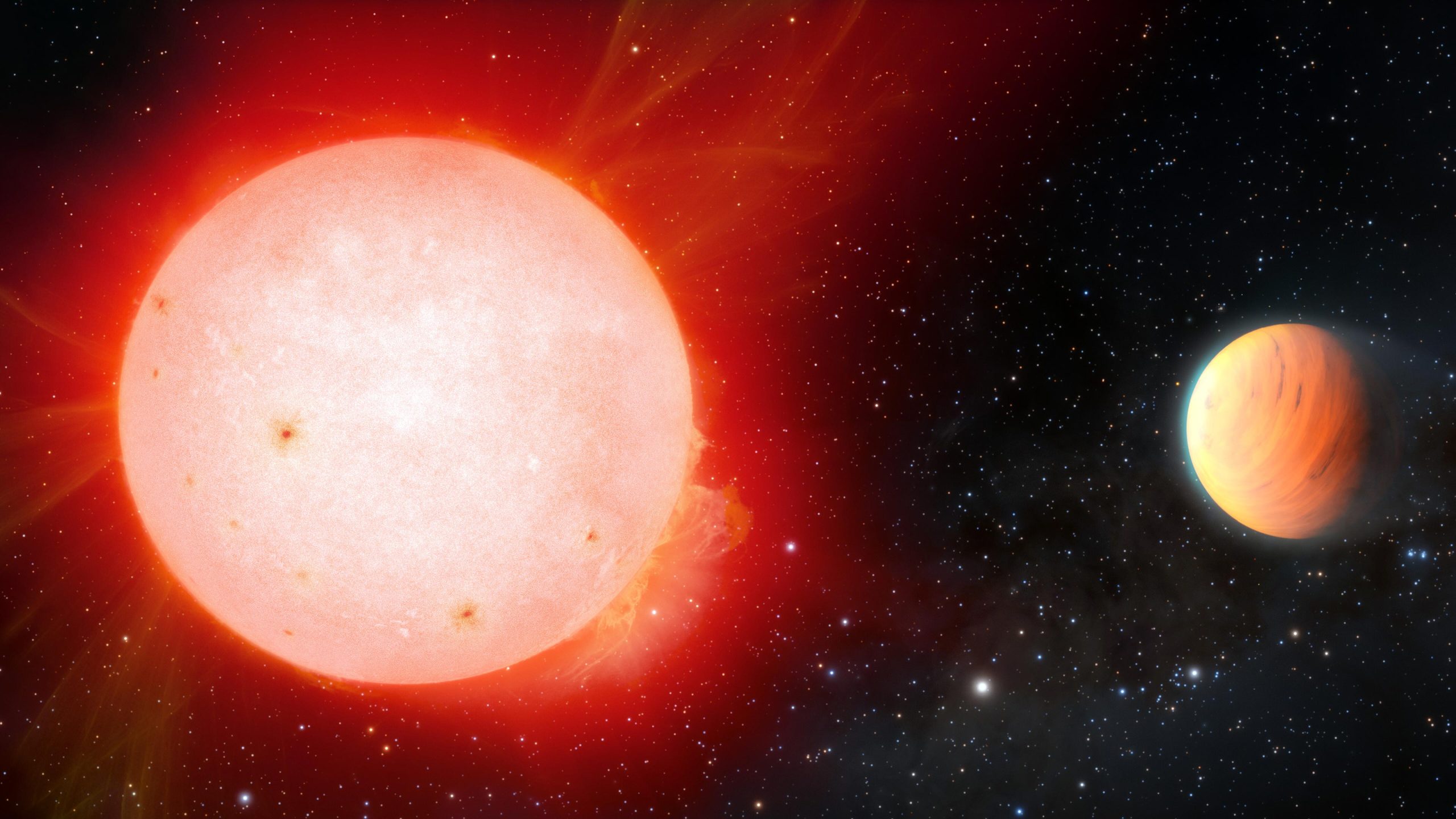Render artis dari planet raksasa gas ultra-berbulu yang mengorbit bintang katai merah. Sebuah planet ekstrasurya gas raksasa [right] dengan kepadatan marshmallow ditemukan di orbit di sekitar bintang katai merah dingin [left] oleh instrumen kecepatan radial NEID yang didanai NASA pada teleskop WIYN 3,5 meter di Observatorium Nasional Kitt Peak, sebuah program NOIRLab NSF. Dinamakan TOI-3757 b, planet ini adalah planet raksasa gas paling lembut yang pernah ditemukan di sekitar bintang jenis ini. Kredit: NOIRLab/NSF/AURA/J. da Silva/Spaceengine/M. Zamani
Teleskop Observatorium Nasional Kitt Peak membantu menentukan ini[{” attribute=””>Jupiter-like Planet is the lowest-density gas giant ever detected around a red dwarf.
A gas giant exoplanet with the density of a marshmallow has been detected in orbit around a cool red dwarf star. A suite of astronomical instruments was used to make the observations, including the NASA-funded NEID radial-velocity instrument on the WIYN 3.5-meter Telescope at Kitt Peak National Observatory, a Program of NSF’s NOIRLab. Named TOI-3757 b, the exoplanet is the fluffiest gas giant planet ever discovered around this type of star.
Using the WIYN 3.5-meter Telescope at Kitt Peak National Observatory in Arizona, astronomers have observed an unusual Jupiter-like planet in orbit around a cool red dwarf star. Located in the constellation of Auriga the Charioteer around 580 light-years from Earth, this planet, identified as TOI-3757 b, is the lowest-density planet ever detected around a red dwarf star and is estimated to have an average density akin to that of a marshmallow.
Red dwarf stars are the smallest and dimmest members of so-called main-sequence stars — stars that convert hydrogen into helium in their cores at a steady rate. Although they are “cool” compared to stars like our Sun, red dwarf stars can be extremely active and erupt with powerful flares. This can strip orbiting planets of their atmospheres, making this star system a seemingly inhospitable location to form such a gossamer planet.
“Planet raksasa di sekitar bintang katai merah secara tradisional dianggap sulit untuk dibentuk,” kata Shubham Kanodia, seorang peneliti di Carnegie Institution for Science’s Earth and Planets Laboratory dan penulis pertama makalah yang diterbitkan di Majalah Astronomil. “Sejauh ini, ini hanya dipelajari dengan sampel kecil dari survei Doppler, yang biasanya menemukan planet raksasa lebih jauh dari bintang katai merah ini. Sampai sekarang, kami belum memiliki sampel planet yang cukup besar untuk menemukan planet gas terdekat dengan andal.”
Masih ada misteri yang belum terpecahkan seputar TOI-3757 b, yang terbesar, tentang bagaimana planet gas raksasa dapat terbentuk di sekitar bintang katai merah, dan khususnya planet yang jarang. Namun, tim Kanodia berpikir mereka mungkin memiliki solusi untuk misteri ini.

Dari dasar Observatorium Nasional Kitt Peak (KPNO), sebuah program NOIRLab NSF, teleskop 3,5 meter Wisconsin-Indiana-Yale-NOIRLab (WIYN) tampaknya mengamati Bima Sakti yang menjulang di cakrawala. Airglow kemerahan, fenomena alam, juga mewarnai cakrawala. KPNO terletak di Gurun Arizona-Sonoran di Tohono O’odham Nation, dan pandangan yang jelas dari bagian bidang galaksi Bima Sakti ini menunjukkan kondisi yang menguntungkan di daerah ini yang diperlukan untuk melihat benda langit yang redup. Kondisi ini, yang meliputi polusi cahaya rendah, langit yang lebih gelap dari 20 orde magnitudo, dan kondisi atmosfer yang kering, telah memungkinkan para peneliti dari konsorsium WIYN untuk melakukan pengamatan galaksi, nebula, dan planet ekstrasurya, serta banyak target astronomi lainnya di WIYN. Teleskop 3,5 meter dan teleskop saudaranya, teleskop WIYN 0,9 meter. Kredit: KPNO/NOIRLab/NSF/AURA/R. Percikan
Mereka menyarankan bahwa kepadatan rendah TOI-3757 b mungkin merupakan hasil dari dua faktor. Yang pertama berkaitan dengan inti berbatu planet ini; Raksasa gas diperkirakan mulai sebagai inti berbatu besar sekitar sepuluh kali massa Bumi. Pada titik ini, mereka dengan cepat menarik sejumlah besar gas tetangga untuk membentuk raksasa gas yang kita lihat sekarang. Bintang TOI-3757b memiliki kelimpahan elemen berat yang lebih rendah dibandingkan dengan bintang katai-M lainnya dengan raksasa gas, yang mungkin menyebabkan inti berbatu terbentuk lebih lambat, menunda timbulnya akresi gas dan karenanya mempengaruhi kepadatan keseluruhan planet .
Faktor kedua bisa jadi orbit planet, yang sementara dianggap sedikit elips. Terkadang ia lebih dekat ke bintangnya daripada waktu lain, menyebabkan panas berlebih yang signifikan yang dapat membuat atmosfer planet membengkak.
Satelit Survei Transit Exoplanet NASA ([{” attribute=””>TESS) initially spotted the planet. Kanodia’s team then made follow-up observations using ground-based instruments, including NEID and NESSI (NN-EXPLORE Exoplanet Stellar Speckle Imager), both housed at the WIYN 3.5-meter Telescope; the Habitable-zone Planet Finder (HPF) on the Hobby-Eberly Telescope; and the Red Buttes Observatory (RBO) in Wyoming.
TESS surveyed the crossing of this planet TOI-3757 b in front of its star, which allowed astronomers to calculate the planet’s diameter to be about 150,000 kilometers (100,000 miles) or about just slightly larger than that of Jupiter. The planet finishes one complete orbit around its host star in just 3.5 days, 25 times less than the closest planet in our Solar System — Mercury — which takes about 88 days to do so.
The astronomers then used NEID and HPF to measure the star’s apparent motion along the line of sight, also known as its radial velocity. These measurements provided the planet’s mass, which was calculated to be about one-quarter that of Jupiter, or about 85 times the mass of the Earth. Knowing the size and the mass allowed Kanodia’s team to calculate TOI-3757 b’s average density as being 0.27 grams per cubic centimeter (about 17 grams per cubic feet), which would make it less than half the density of Saturn (the lowest-density planet in the Solar System), about one quarter the density of water (meaning it would float if placed in a giant bathtub filled with water), or in fact, similar in density to a marshmallow.
“Potential future observations of the atmosphere of this planet using NASA’s new James Webb Space Telescope could help shed light on its puffy nature,” says Jessica Libby-Roberts, a postdoctoral researcher at Pennsylvania State University and the second author on this paper.
“Finding more such systems with giant planets — which were once theorized to be extremely rare around red dwarfs — is part of our goal to understand how planets form,” says Kanodia.
The discovery highlights the importance of NEID in its ability to confirm some of the candidate exoplanets currently being discovered by NASA’s TESS mission, providing important targets for the new James Webb Space Telescope (JWST) to follow up on and begin characterizing their atmospheres. This will in turn inform astronomers what the planets are made of and how they formed and, for potentially habitable rocky worlds, whether they might be able to support life.
Reference: “TOI-3757 b: A low-density gas giant orbiting a solar-metallicity M dwarf” by Shubham Kanodia, Jessica Libby-Roberts, Caleb I. Cañas, Joe P. Ninan, Suvrath Mahadevan, Gudmundur Stefansson, Andrea S. J. Lin, Sinclaire Jones, Andrew Monson, Brock A. Parker, Henry A. Kobulnicky, Tera N. Swaby, Luke Powers, Corey Beard, Chad F. Bender, Cullen H. Blake, William D. Cochran, Jiayin Dong, Scott A. Diddams, Connor Fredrick, Arvind F. Gupta, Samuel Halverson, Fred Hearty, Sarah E. Logsdon, Andrew J. Metcalf, Michael W. McElwain, Caroline Morley, Jayadev Rajagopal, Lawrence W. Ramsey, Paul Robertson, Arpita Roy, Christian Schwab, Ryan C. Terrien, John Wisniewski and Jason T. Wright, 5 August 2022, The Astronomical Journal.
DOI: 10.3847/1538-3881/ac7c20

“Ninja twitter bersertifikat. Ahli internet. Penggemar budaya pop hardcore. Baconaholic.”
You may also like
-
Aturan matematika ditemukan di balik distribusi neuron di otak kita
-
Para ilmuwan menemukan penjelasan untuk lubang gravitasi raksasa di Samudra Hindia
-
Peta baru yang akurat dari semua materi di alam semesta dirilis
-
Para ilmuwan mengatakan sepasang bintang yang sangat langka berperilaku sangat ‘aneh’
-
Lima Angsa Tewas Setelah Terbang Ke Saluran Listrik Hinkley | Berita Inggris

